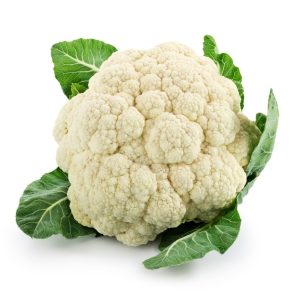- Botanical Name & Family: Brassica oleracea Botrytis Group, Brassicaceae (crucifer family) .
- Plant Description: Biennial plant, grown as an annual for its edible “curd” (fused flower head). Closely related to broccoli. White curds are traditional, but colored varieties (orange, green, purple) exist. Intolerant of heat, drought, and freezing.
- Cultivation Tips: Cool-weather vegetable, grown as spring or fall crop. Sow seeds indoors 6-8 weeks before last spring frost. Requires consistent moisture and fertility. Some varieties are “self-blanching”; others need leaves tied to protect curd from sun. Susceptible to cabbage looper.
- Ayurvedic Description: Light to digest, suitable for balancing Kapha due to its drying and slightly astringent nature. Can kindle digestive fire (Agni) and clear Ama (toxins). Can increase Vata due to dry/rough qualities, so Vata types should consume in moderation, cooked with Vata-balancing spices and ghee.

Nutritional profile of seasonal vegetable (per 100g raw edible portion):
| Vegetable | Botanical Name | Calories (kcal) | Carbohydrates (g) | Protein (g) | Fat (g) | Fiber (g) | Key Vitamins | Key Minerals |
| Cauliflower | Brassica oleracea | 25 / 27 | 5 / 5 | 2 / 2 | 0 / 0 | 2 / 2 | C (100% DV) , C (57 mg) | K (270 mg) , Ca, Fe, Na |
